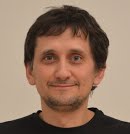 Branislav Mičušík is a senior scientist at the Austrian Institute of Technology. Prior to that in ’07-’09 he was a visiting research scholar at Stanford University, USA. In ’04-’07 he was a postdoctoral researcher at the Vienna University of Technology, Austria. He received his Ph.D. in ’04 from the Czech Technical University in Prague, at the Center of Machine Perception. His research interests are driven by wish to learn computers and machines to understand what they see in order to infer their own location. He is a holder of the Microsoft Visual Computing Award 2011 given to the best young scientist in Visual Computing in Austria and the Best Scientific Paper Prize at the British Machine Vision Conference in ’07. His talk takes place on Wednesday, May 27, 11am in room E104.
Branislav Mičušík is a senior scientist at the Austrian Institute of Technology. Prior to that in ’07-’09 he was a visiting research scholar at Stanford University, USA. In ’04-’07 he was a postdoctoral researcher at the Vienna University of Technology, Austria. He received his Ph.D. in ’04 from the Czech Technical University in Prague, at the Center of Machine Perception. His research interests are driven by wish to learn computers and machines to understand what they see in order to infer their own location. He is a holder of the Microsoft Visual Computing Award 2011 given to the best young scientist in Visual Computing in Austria and the Best Scientific Paper Prize at the British Machine Vision Conference in ’07. His talk takes place on Wednesday, May 27, 11am in room E104.
Calibrating Surveillance Camera Networks
Abstract: Camera systems have witnessed a huge increase in the number of installed cameras, generating a massive amount of video data. Current computer vision technologies are not fully able to exploit the visual information available in such large camera networks partially due to the lack of information about camera exact location. A manual calibration with special calibration targets, especially in ad hoc large camera networks, does not scale well with the number of cameras, is too time consuming, hence impractical. Therefore, a fully or semi automatic method with minimal user effort is an inevitable objective which should solely rely on visual information.
I present three approaches to tackle the calibration and localization problem of self-calibrating camera networks purely relying on available visual data. First, I present an approach for the calibration of cameras building on the latest achievements in Structure from Motion community. This stands for localization a camera in a priori built 3D model consisting of either points or line segments. Second, and third respectively, our approaches calibrating a single camera, and multiple surveilance cameras respectively, from detecting and tracking people will be reviewed. I show how multiple view geometry between overlapping and non-overlapping camera views with static and dynamic point correspondences gives a strong cue towards calibrating the cameras yielding practically appealing solutions.